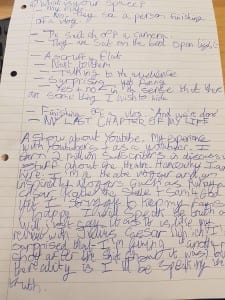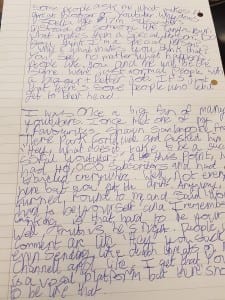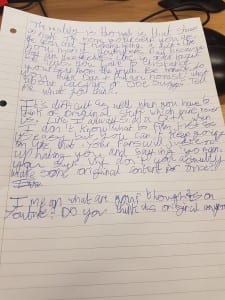In being able to analyse solo performance, one must be able to observe the various methods of solo performance put into practice. Indeed, by being able to analyse the piece, we are therefore able to see ideas placed into practice. This was clearly shown in Paul O’Donnell’s solo show “We’ve Got Each Other” which I got the opportunity to watch on the 8th February at Lincoln Drill Hall.
(O’Donnell,2017).
In Paul O’Donnell’s solo comedy musical, he takes on the premise that he was going to do a new Jukebox musical based on the music of Jon Bon Jovi except what he proposed has been denied. Through the set of lights and some effects such as sound and mist, we then have to imagine the musical as he reads the show to us as a workshop. Thus, we could say that he makes some interesting statements concerning musical theatre and that there has been a reliance on technology and the story to “spell out” the story out to us.
During the show, there was mainly a few changes that I was able to categorise as lighting and sound, dialogue in the musical, spectacle and the breakage of performance. The reason was as the concept was based on a supposed workshop of the show, it contained many sections concerning this in which Paul O’Donnell would have direct contact with the audience as if we were imagining what the show would look like instead of having it been made obvious for us through the spectacle of the musical. This not only created comedy but also allowed us to imagine the world of this show and let us have breathing space in letting us take in the shows spectacle.
However, what was interesting was particularly the ending in which O’Donnell decided to break the formula. Whilst there was still a sense of us being asked to imagine this spectacle, the show changed the formula in which O’Donnell showed us a final dance scene between Gina’s cousin, José, and Gina’s forbidden lover, Tommy. In doing this dance, he broke the rules by leaving the chair he had been sat on during the entirety of the show and therefore allowed us to get an idea of this choreography that would occur in this final fight in which Tommy would die. Whilst some may say that this idea to show it compared to getting us to imagine it, I felt it was very successful as it made us understand the style of dance that would happen in this knock off Paso Doblé dance.
Thus, in conclusion of this post, Paul O’Donnell’s piece was seen to me as a success. Partly, this is down to my own self love and passion for musical theatre as I love it but as well, it is also down to his witty comments among musicals. Particularly, the Jukebox musical which has always been seen as a bit tacky and lazy at times. His use of sound, dialogue, lighting and movement allows us to have breathing space and imagine the world of this make believe musical. As well, the use of this “stripped back” production highlights to us the issues that can arise when creating a musical based on the songs of an artist and what traps can arise concerning corny one liners to introduce the song or even a character and the amount of reprises of a song that can be done differently to wow an audience when it is exactly the same song but with a different tempo, different key change and is different to the first time you heard it. By a mile, it is hysterical and also very cynical in the way it approaches musical theatre but has helped me in understanding the importance of why there is a fourth wall. And of course, it’s musicals so why wouldn’t you want to watch something like that?
In self reflection of the piece, I have gained a lot from observing this piece. It has allowed me to understand how the fourth wall can be broken as well as the breakage of rules that you can set up in a theatre. It has also helped me in understanding the distinction of actor/audience relationship and this is something I wish to take on for my solo piece as well as the idea of stripping yourself back and making yourself very bare onstage. Finally, I have also learnt that ripping to shreds musicals is great fun and entertaining to watch even if you are a fan of musicals and this is something I hope to use with the idea of YouTubing and the community of YouTube.



